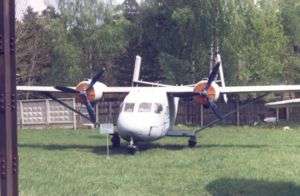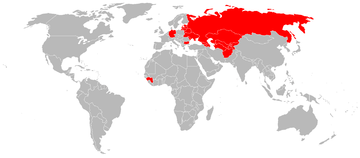Antonov An-14
| An-14 Pchelka | |
|---|---|
 | |
| Preserved An-14 on public display. | |
| Role | Utility transport |
| Manufacturer | Antonov |
| First flight | 1958 |
| Introduction | 1966 |
| Status | In service as private aircraft |
| Primary users | Soviet Air Force Aeroflot Afghan Air Force East German Air Force |
| Produced | 1966–1972 |
| Number built | 332 |
| Developed into | Antonov An-28 |

The Antonov An-14 Pchelka (Russian: «Пчелка», "Little Bee", (NATO reporting name Clod)[1] is a Soviet utility aircraft which was first flown on 15 March 1958.[2] It was a twin-engined light STOL utility transport, with two 300 hp Ivchenko AI-14RF radial piston engines. Serial production started in 1966, and about 300 examples were built by the time production ended in 1972. The An-14 failed to replace the more successful An-2 biplane, which was manufactured until 1990, (the An-2 is still manufactured on special orders). The An-14's successor, the An-28 with turboprop engines, is still manufactured at PZL Mielec factories in Poland under the names PZL M28 Skytruck and PZL M28B Bryza.
With very stable flight characteristics, the An-14 could be flown by most after a few hours of basic training. A small number of An-14 are still in airworthy condition.
Operators

- The Afghan Air Force operated 12 from 1985 through 1991.
- Mongolian People's Air Force- operated 2 from early 1970s through 1980
Specifications (An-14)
.jpg)
Data from Soviet Transport Aircraft since 1945[3]
General characteristics
- Crew: two
- Capacity: 6–8 passengers or 720 kg (600 kg) cargo
- Length: 11.36 m (37 ft 3 in)
- Wingspan: 21.99 m (72 ft 1¾ in)
- Height: 4.63 m (15 ft 2¼ in)
- Wing area: 39.72 m² (427.5 ft²)
- Aspect ratio: 12.15:1
- Empty weight: 2,600 kg (5,732 lb)
- Loaded weight: 3,450 kg (7,606 lb)
- Max. takeoff weight: 3,600 kg (7,936 lb)
- Powerplant: 2 × Ivchenko AI-14RF air-cooled radial engines, 224 kW (300 hp) each
Performance
- Cruise speed: 180 km/h (97 knots, 112 mph)
- Range: 650 km (350 nmi, 564 mi)
- Service ceiling: 5,000 m (16,400 ft)
- Landing Speed: 80 km/h (43 knots, 50 mph)
- Landing Roll: 110 m (360 ft)
- Takeoff Roll: 100–110 m (328–360 ft)
- Cabin size: 3.1 x 1.53 x 1.6 m (10 ft 2 in x 5 ft x 5 ft 3 in)
See also
- Related development
- Aircraft of comparable role, configuration and era
References
- Stroud, John. Soviet Transport Aircraft since 1945. London:Putnam, 1968. ISBN 0-370-00126-5.
- Taylor, John W. R. Jane's All The World's Aircraft 1976–77. London: Jane's Yearbooks. ISBN 0-354-00538-3.
The initial version of this article was based on material from aviation.ru. It has been released under the GFDL by the copyright holder.
External links
| Wikimedia Commons has media related to Antonov An-14. |
- Walkaround An-14 from Aviatechnical museum, Lugansk, Ukraine
- Walkaround An-14 from Civil Aviation Museum, Ulyanovsk, Russia